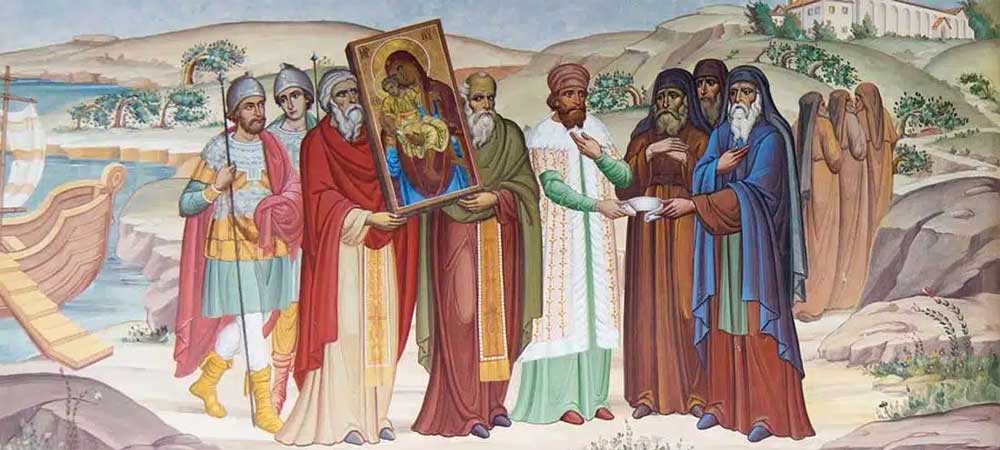Life and martyrdom of Saint George
 Saint George is one of the most popular Saints throughout the Christian world. He is also called Great Martyr and Tropy Bearer (Tropeoforos) . Especially in Greece, there is no region that does not have a chapel or a church dedicated to his memory, while the name George is one of the most common Greek names.
Saint George is one of the most popular Saints throughout the Christian world. He is also called Great Martyr and Tropy Bearer (Tropeoforos) . Especially in Greece, there is no region that does not have a chapel or a church dedicated to his memory, while the name George is one of the most common Greek names.
Saint George was born between 275-281 AD, in Nicomedia, Bithynia. His father Gerontius came from a wealthy family of Cappadocia and was a military man and a senator. His mother Polychronia came from Lydda in Palestine. Both of Georgios’ parents were baptized Christians.
After his father’s death, the Saint’s family moved to Lydda, his mother’s hometown. At a young age, George pursued a military career and joined the Roman Army. He quickly distinguished himself for his abilities and bravery and received the office of Tribunus. Emperor Diocletian promoted him to Commander) and Colonel in the imperial guard corps.
In 303 AD Diocletian began fierce persecutions against the Christians. George refused to carry out his orders and professed his faith. The emperor, who did not expect this behavior from one of his own people, ordered that George be subjected to horrible tortures in order to renounce his faith.
After stabbing him, they tore through his flesh with a special wheel of knives. He was then thrown into a pit of slaked lime and then forced to walk in hot metal shoes. George bravely endured the martyrdom and on April 23, 303 he was beheaded on the walls of Nicomedia. On this date he is commemorated throughout the Christian world, with the exception of the Orthodox churches, when April 23 falls before Easter or coincides with Easter, because his service includes resurrection hymns. In this case, the commemoration of Saint George is postponed to Monday after the Greek Easter.
The remains of George, together with that of his mother, who was martyred on the same or the following day, were taken and buried in Lydda. From there, as the sources confirm, the Crusaders took the holy relics of Agia Polychronia and transported them to the West. Constantine the Great built a temple on the tomb of George.
The wonderful courage that George displayed during his martyrdom and the miracles he performed contributed to the conversion of many present Romans to Christianity, with the most prominent case of Diocletian’s wife, Alexandra, who embraced Christianity together with the slaves of Apollo, Isaakio and Kodrato. Their memory is commemorated on April 21.
George’s fame spread throughout the East. Already, in the 4th century, there were temples in Syria with his name, while in Egypt 40 temples and 3 monasteries had been built in his honor. A church of George is mentioned in Constantinople, already, from the time of Constantine the Great. Ecclesiastical poets, such as Romanos Melodos, dedicated triumphant hymns and eulogies to him, proclaiming him as abright star, shining like the sun.
Saint George and the Dragon
The myth of Saint George the dragon slayer is a classic legend that blends elements of folklore and religion, resonating through many cultures around the world. Saint George is most commonly associated with Christian hagiography, where he is revered as a martyr. According to the most popular version of the story, Saint George was a Roman soldier of Greek origin and a member of the Praetorian Guard for Roman emperor Diocletian. The story is set in a place called Silene, in Libya.
The legend describes how a dragon lived in a lake near Silene and terrorized the populace by poisoning the countryside. To appease the dragon, the people of Silene provided two sheep each day, and when sheep were no longer plentiful, they sacrificed humans instead. The victims were chosen by lottery, and one day the lot fell on the princess of Silene, Cleolinda, the daughter of the king.
As Cleolinda was being led to the lake to be sacrificed, Saint George fortuitously rode past. The princess tried to send him away, but he vowed to remain and confronted the dragon. He made the sign of the cross and charged it on horseback, managing to wound it with his lance. George then captured the dragon and led it back to Silene, where he offered to kill the beast if the townspeople would convert to Christianity. The king and the people of Silene converted to Christianity, George slew the dragon, and the body of the beast was carted out of the city on four ox-carts.
The myth of Saint George and the dragon is steeped in the theme of good conquering evil and faith overcoming adversity, and it has been celebrated in many cultures as an example of chivalry and bravery. The story has been adapted and retold numerous times across Europe and the Middle East, each adding its own cultural touches to the legend.
Celebration of St George’s day
Saint George’s Day, celebrated on April 23rd, commemorates his martyrdom and is a day of celebration in many countries and among many Christian denominations. The myth also heavily influences art and literature, inspiring countless portrayals in paintings, sculptures, and writings throughout the centuries.
